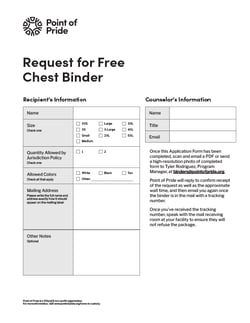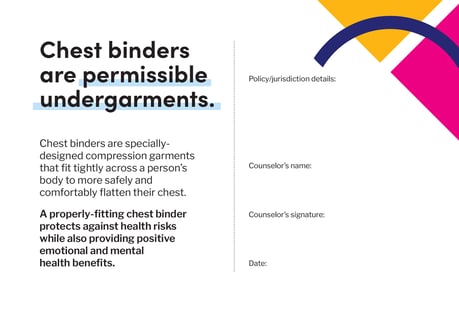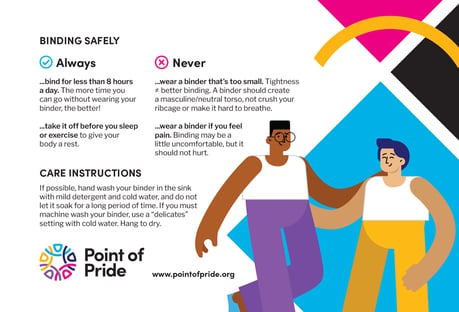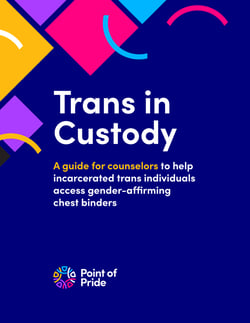Trans in Custody
Helping trans people in incarceration access gender-affirming chest binders.
About this project
In collaboration with the NYC Department of Correction’s LGBTQ+ Affairs Unit, Point of Pride has produced a series of resource guides designed to help trans people in incarceration to access gender-affirming chest binders.
This information is designed to support:
- counselors in correctional facilities
- LGBTQ+ organizations advocating on behalf of trans folks in incarceration
- the friends, family, and loved ones of a trans person in incarceration
If you have a question not covered here or wish to provide feedback, please contact us.
Special thanks to Elizabeth Munksy, Executive Director of LGBTQ+ Affairs at the NYC Department of Correction, for her collaboration in developing these resources.
Resource Guides
Need & impact
What are chest binders?
Chest binders are specially-designed compression garments that fit tightly across a person’s body to more safely and comfortably flatten their chest. For transgender men and non-binary individuals, chest binders allow them to have a more masculine or gender-neutral appearance. According to several studies including one from the International Journal of Transgender Health,1 chest binders lessen gender dysphoria, improve body image, enhance self-esteem, and help people feel more affirmed in their gender identity.

How do they work?
Chest binders are constructed out of nylon and spandex, with an inner panel on the front of the garment to provide compression. They can come in any color, but are often white, black, or tan in color. When worn underneath a shirt, a chest binder resembles a snug-fitting undershirt or sports bra.
Why do they matter?
Without access to chest binders, trans people are far more likely to turn to unsafe binding methods to compress their chest, such as Ace bandages, plastic wrap, surgical garments, duct tape, or other materials. These methods can cause strain or even serious physical injury such as skin irritation (rashes, blisters), breathing issues (shortness of breath, chest pain, fainting), and even fractured ribs.
Chest binders’ impact on trans individuals in custody
A properly-fitting chest binder protects against health risks while also providing positive emotional and mental health benefits. A 2017 study2 found that the mental health effects of binding safely “were almost universally positive” among those surveyed, with more than 70% of individuals reporting a positive mood and decreased dysphoria, depression, anxiety, and suicidality.
1. Fung, K. A., Zucker, I. K., & Pryor, J. (2020). The impact of chest binding on mental health in transgender individuals. International Journal of Transgender Health, 21(1), 26-32. doi: 10.1080/26895269.2019.1709717
2. Peitzmeier, S., Gardner, I., Weinand, J., Corbet, A., & Acevedo, K. (2017). Health impact of chest binding among transgender adults: A community-engaged, cross-sectional study. Culture, Health & Sexuality, 18(4), 1-15. doi: 10.1080/13691058.2016.1191675
Ensuring binders are permissible items
The permissible items list (sometimes called the allowable items list) is usually available on the facility's website, and/or in public spaces for families and loved ones to know what items they can send.
- If chest binders are on the list: Bookmark, print out, or otherwise note any information you find that lists chest binders as a permissible undergarment item. If there’s a policy number or point of contact, save that info as well.
- If chest binders are not on the list: You will first request to add them following the jurisdiction's protocols. (Our downloadable resource guides can point you in the right direction.)
Here are some helpful tips to advocate on behalf of the incarcerated individual:
- Research local laws around gender identity and gender expression: Start by identifying the government agencies that oversee laws related to gender identity and expression in your area. These may include state human rights commissions, local law enforcement agencies, or LGBTQ+ advocacy organizations. Check for existing laws or policies that protect transgender individuals from discrimination based on gender identity or expression. Then, stay up to date on any changes or updates to laws by subscribing to newsletters from government agencies, following relevant legal or advocacy groups on social media, or attending community events or town hall meetings.
- Provide facility leadership with information: Download this one-sheet specifically tailored for facility leadership.
- Repeat information as necessary: Consistently emphasize the benefits of chest binder access, including how it can benefit both the individual and the facility. Mention any applicable nondiscrimination laws.
- Connect with local LGBTQ+ non-profits and/or trans competent doctors: Network with external organizations and experts who are trans-affirming and can offer you supplementary information and/or support as you advocate on behalf of incarcerated trans individuals. By referencing these connections, facility leadership may be more receptive to implementing trans-inclusive policies, including allowing access to chest binders.
Buy a binder
If financial means allow for the purchase of a chest binder for the person in inarceration, we recommend the following retailers:
- gc2b.co is proudly trans-owned and operated, and has high-quality binders for all body shapes and sizes from XXS–5XL.
- Origami Customs is a trans-owned and operated underthings retailer specializing in gender-affirming products, including custom, made-to-measure binders.
- Underworks has a number of different style binders, the most popular being their double-front compression shirt and tri-top compression shirt.
- Shapeshifters offers custom, made-to-measure chest binders.
You’ll still want to ensure chest binders are permissible items, and that the facility mailroom is aware of the package.
How to request a free chest binder through Point of Pride
Founded in 2016, Point of Pride is a 501(c)(3) non-profit organization. One of the programs we offer is a chest binder donation program, in which we mail free garments directly to trans people who cannot otherwise access them. 100% of purchase and shipping costs are covered by Point of Pride.
There is no cost to the recipient or to the corrections facility.
Step 1
Ensure chest binders are on the permissible items list as an undergarment item.

Step 2
Print this Application Packet and provide it to the person in custody. Page 1 is what is returned to Point of Pride. Page 2 contains a printable measuring tape with instructions so the recipient can measure themselves to determine their correct size.
Step 3
Once the Application Form has been completed, the incarcerated person's counselor should scan and email a PDF or send a high-resolution photo to us at binders@pointofpride.org.
Step 4
Point of Pride will reply to the counselor to confirm receipt of the request as well as the approximate wait time, and then email a tracking number once the binder is in the mail.
Step 5
The counselor should speak to the mail receiving room at the facility to ensure the package will not be refused.
FAQ
What does packaging look like?
What is included in the package?


What happens if the binder is refused by the mail receiving room?
The person in custody lost their binder/it was damaged/it was confiscated. What is your replacement policy?
If you have a question not covered here or wish to provide feedback, please contact us.
